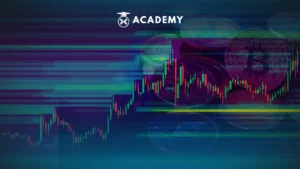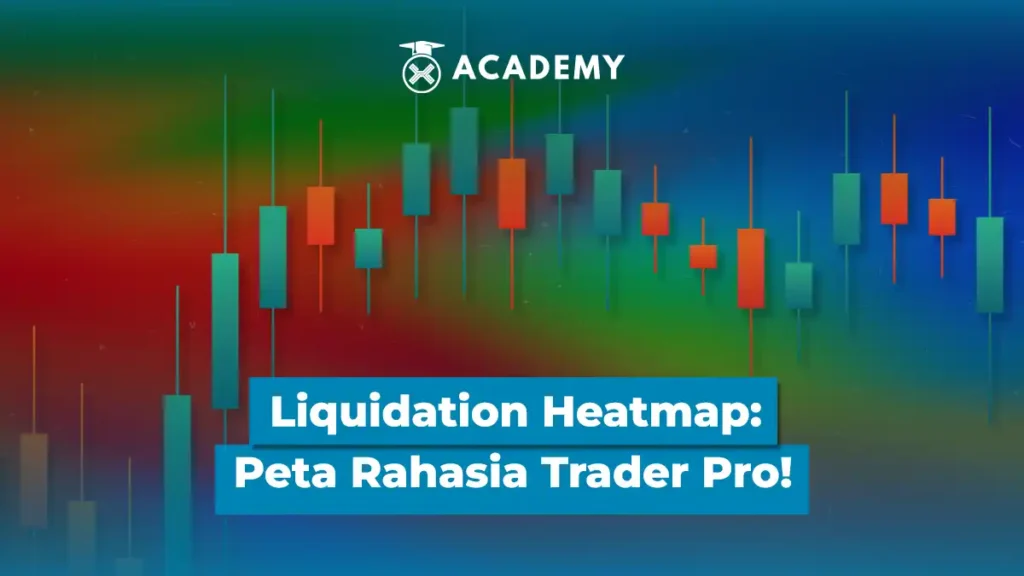Many traders are often surprised to find their positions liquidated, even though they felt they had set a stop loss at a safe level.
This is where the liquidation heatmap comes into play, acting as a “secret map” that professional traders use to identify potential market traps.
This article will help you understand what a liquidation heatmap is, how to read it, and how to utilize it in trading.
What Is a Liquidation Heatmap?

A liquidation heatmap can be understood as a visualization of price areas that show where leveraged positions, both long and short, are potentially liquidated if the price moves to a certain level.
This can cause losses for traders because their positions are automatically closed, and can also trigger sharper price movements in the market.
By viewing this map, traders can identify vulnerable points that often become magnets for market movements.
Unlike order books, which display the buying and selling intentions of market participants, liquidation heatmaps reveal trader weaknesses.
While order books show transaction plans, heatmaps show where risk pools are located, thus providing a better understanding of potential market pressure.
It’s called a “heatmap” because the information is visualized using color. Typically, yellow, orange, and red are used to indicate intensity.
The more intense the color, the greater the concentration of positions vulnerable to liquidation in that price area.
Who First Popularized Liquidation Heatmaps?
Liquidation heatmaps were first popularized by several large platforms such as Coinglass, Hyblock Capital, and TradingLite.
They are known as pioneers in providing heatmap visualizations to identify price areas prone to liquidation in the crypto market.
This tool quickly gained popularity among futures traders, especially those active in crypto futures contracts, because it can show where market pressure can arise and how potential price movements can develop.
This allows traders to be better prepared for the volatility that often results from mass liquidations.
In fact, it’s not just retail traders who utilize it. Hedge funds and large players often use heatmaps for stop-hunting strategies, pushing prices into areas filled with liquidation-prone positions.
When a wave of mass liquidations occurs, they then profit from the resulting price movements.
The Main Function of a Liquidation Heatmap
A liquidation heatmap serves as an analytical tool that helps traders understand derivatives market behavior. Some of its main functions include:
1. Showing price levels where massive liquidations are likely to occur
The heatmap shows price areas filled with leveraged positions with liquidation levels close together. When the price moves into these zones, a wave of liquidations often occurs, driving higher market volatility.
2. Acting as a hidden support and resistance indicator
In addition to standard technical levels, the heatmap reveals areas that frequently attract price movements. These liquidation clusters can act as additional support or resistance that is not visible on conventional charts.
3. Helping traders avoid areas prone to traps
By viewing this map, traders can be more vigilant and avoid entering positions in areas that are potentially swept away by price movements. This is very helpful in reducing the risk of stop hunting.
4. Showing target points for whale movements or market manipulation
Large players often target areas with concentrated liquidation positions to trigger mass forced closures. The heatmap provides a clear picture of where the target is likely to be.
How to Read a Liquidation Heatmap
Liquidation heatmaps use color visualization to show the concentration of positions vulnerable to liquidation.
The brighter the color (usually yellow to red), the more leveraged positions that could be forced to close if the price moves to that level.
Conversely, darker areas indicate a lower risk of liquidation because there are fewer positions accumulated there.
An example can be seen in the BTC/USDT. pair. For example, there is a large cluster of long positions around the $65,000 level, visualized in bright red.
If Bitcoin’s price were at $70,000 and then began to fall near that area, many long positions could be liquidated simultaneously. Consequently, the price decline could accelerate as the wave of liquidations drives the market.
It’s also important to distinguish between long and short liquidation clusters. The bright zone below the current price usually indicates an area where long positions are vulnerable to being wiped out if the price falls.
Conversely, the light zone above the price represents an area containing short positions, which could be exposed to a short squeeze if the price rises.
The interpretation of a heatmap also depends heavily on the market context. If trading volume is high and the price is approaching a cluster, the chance of triggering a liquidation is greater.
However, if the price moves sideways near the cluster without breaking through it, the area could serve as a form of hidden support or resistance.
For beginners, a simple analogy is to imagine a heatmap as a “heat map” showing where price mines are placed.
If the price approaches these mines, there is the potential for an explosion in the form of mass liquidations that can rapidly move the market.
Trading Strategies with Liquidation Heatmaps
Liquidation heatmaps are not only a tool for analyzing risk but can also be used as the basis for various trading strategies. Here are some ways to apply them:
1. Scalping & Day Trading
Short-term traders can use heatmaps to identify potential liquidity grabs. When the price touches a bright zone containing positions prone to liquidation, a spike in volatility usually occurs, which can be exploited for quick entry.
2. Swing Trading
For more patient traders, heatmaps help identify consolidation areas and potential breakout points. Liquidation clusters often serve as psychological levels that determine the direction of the next trend.
3. Risk Management
Heatmaps also serve as a risk management guide. By avoiding entry near large liquidation clusters, traders can minimize the chance of being swept up in forced movements that trigger losses.
For example, suppose Bitcoin is falling near the $65,000 area, which is marked as a long liquidation cluster. Once the price touches this level, many long positions are forced to close, triggering a rapid decline.
However, after this “mine” explodes, the market can actually bounce as selling pressure subsides and large players take new positions.
Advantages & Disadvantages of Liquidation Heatmaps
Liquidation heatmaps have many benefits, but they also have limitations. This tool is effective when used in conjunction with other analysis, not as a standalone. Here are some of its advantages and disadvantages:
1. Advantages
- Provides a more transparent picture because decisions can be based on real data from open leveraged positions
- Helps understand market psychology by showing risk areas where many traders are potentially liquidated
- Shows volatility zones before price movements actually occur, thus providing early signals of potential large movements
- Suitable for combination with open interest data because both highlight leveraged positions and market pressure levels
2. Disadvantages
- Cannot provide certainty about the direction of price movements. For example, even if there are many short positions above the current price, this doesn’t necessarily mean the price will rise to break through it.
- Data can sometimes be delayed or not entirely accurate due to differences in sources, update times, or data filters between platforms.
- Traders are susceptible to bias if they rely solely on heatmaps without considering other technical factors such as trends, volume, or market sentiment.
As a tip for using them, liquidation heatmaps should be used in conjunction with other technical analysis such as support and resistance, volume profiles, and trendlines for a more balanced market reading and more accurate trading decisions.
Popular Platforms Providing Liquidation Heatmaps

Several platforms offer liquidation heatmap features with varying characteristics and functions. Here are three of the most widely used by traders:
1. Coinglass
Provides real-time liquidation maps for major assets like BTC and ETH. . Coinglass aggregates data from various exchanges and displays it visually, complete with time and leverage filters.
The interface is simple and easy to understand, making it ideal for both beginners and experienced traders who want to quickly monitor market liquidation pressure.
2. Hyblock Capital
A more advanced platform widely used by professional traders. Hyblock not only displays liquidation maps but also provides derivatives analysis data, order flow, and average market positions (average entry levels).
This feature helps users identify potential areas for large liquidations with high accuracy.
3. TradingLite
Combines order book visualization with heatmaps in one interactive display. Traders can view market depth and liquidation movements simultaneously.
Suitable for users who want to monitor price dynamics, volume, and buying/selling interest visually and in real-time.
Practical Tips for Using Liquidation Heatmaps
Several simple steps can help you utilize liquidation heatmaps more effectively when analyzing crypto market movements. Here are some of them:
1. Don’t just use heatmaps.
Heatmaps should be used as a supporting tool, not the primary determinant of trading decisions. Combine them with technical analysis such as support-resistance, volume, or RSI to ensure the signals generated are more valid and less misleading.
2. Focus on large clusters, not small noise.
Areas with large concentrations of liquidation usually indicate the potential for strong price movements. Meanwhile, small or random dots are often just noise that doesn’t significantly impact the price trend.
3. Pay attention to the timeframe (intraday vs. swing).
Day traders can focus on short-term heatmaps such as the 1-hour or 4-hour timeframe, while swing traders should look at liquidation areas on longer timeframes to capture major momentum or potential breakouts.
Note: Heatmaps can be used as a tool for whale hunting, so retail traders should exercise extra caution. Large players (whales) sometimes exploit liquidation areas to manipulate prices and trap small traders.
Therefore, always ensure confirmation of real price movements before entering positions in areas of high liquidation.
Conclusion
So, that was an interesting discussion about Liquidation Heatmap: The Secret Map of Pro Traders! You can read more about it in the INDODAX Academy Crypto Academy.
In conclusion, the liquidation heatmap can be considered a “secret map” that helps traders see where potential market traps are hidden.
This tool is not for predicting price direction, but rather as a guide so you can read market dynamics more intelligently.
By understanding how it works, traders can avoid sudden losses and make decisions with greater confidence.
By the way, in addition to gaining in-depth insights through various popular crypto education articles, you can also broaden your horizons through a collection of tutorials and choose from a variety of popular articles that suit your interests.
Besides updating your knowledge, you can also directly monitor digital asset prices on the Indodax Market and stay up-to-date with the latest developments through the latest crypto news. For a more personalized trading experience, explore Indodax’s OTC trading service. Don’t forget to activate notifications so you don’t miss out on important information about blockchain, crypto assets, and other trading opportunities.
You can also follow our latest news via Google News for faster and more reliable access to information. For an easy and secure trading experience, download the best crypto app from INDODAX on the App Store or Google Play Store.
Maximize your crypto assets with the INDODAX Earn feature, a practical way to earn passive income from your stored assets. Register now with INDODAX and easily complete KYC to start trading crypto more safely, conveniently, and reliably!
Indodax Official Contact
Customer Service Number: (021) 5065 8888 | Support Email: [email protected]
Also follow us on social media here: Instagram, X, Youtube & Telegram
FAQ
1.What is a liquidation heatmap?
A visual map of price areas where leveraged positions are vulnerable to liquidation.
2.Is a liquidation heatmap accurate?
Not 100% accurate, but very useful for identifying psychological market areas.
3.Can beginners use heatmaps?
Yes, as long as they understand the basics of support/resistance and risk management.
4.The best platform for viewing liquidation heatmaps?
Coinglass and Hyblock are currently the top choices for traders.
5.Are heatmaps only for BTC?
No, many are also available for ETH, major altcoins, and even crypto indices.
Author: Boy






 Polkadot 9.23%
Polkadot 9.23%
 BNB 0.57%
BNB 0.57%
 Solana 4.89%
Solana 4.89%
 Ethereum 2.37%
Ethereum 2.37%
 Cardano 1.22%
Cardano 1.22%
 Polygon Ecosystem Token 2.17%
Polygon Ecosystem Token 2.17%
 Tron 2.83%
Tron 2.83%
 Market
Market


